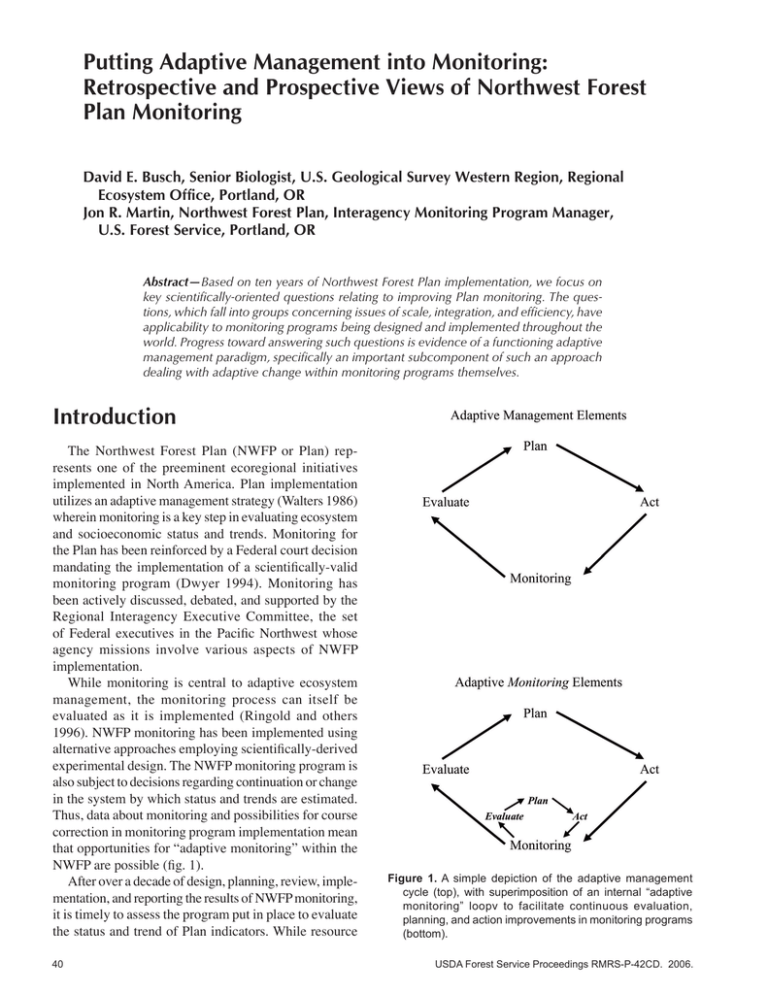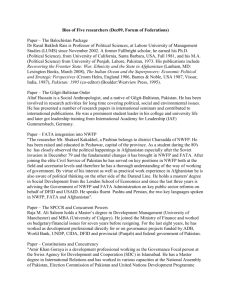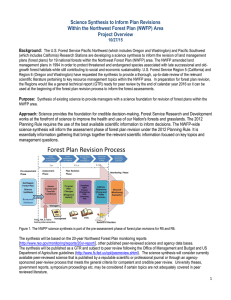Putting Adaptive Management into Monitoring: Plan Monitoring
advertisement

Putting Adaptive Management into Monitoring: Retrospective and Prospective Views of Northwest Forest Plan Monitoring David E. Busch, Senior Biologist, U.S. Geological Survey Western Region, Regional Ecosystem Office, Portland, OR Jon R. Martin, Northwest Forest Plan, Interagency Monitoring Program Manager, U.S. Forest Service, Portland, OR Abstract—Based on ten years of Northwest Forest Plan implementation, we focus on key scientifically-oriented questions relating to improving Plan monitoring. The questions, which fall into groups concerning issues of scale, integration, and efficiency, have applicability to monitoring programs being designed and implemented throughout the world. Progress toward answering such questions is evidence of a functioning adaptive management paradigm, specifically an important subcomponent of such an approach dealing with adaptive change within monitoring programs themselves. Introduction The Northwest Forest Plan (NWFP or Plan) represents one of the preeminent ecoregional initiatives implemented in North America. Plan implementation utilizes an adaptive management strategy (Walters 1986) wherein monitoring is a key step in evaluating ecosystem and socioeconomic status and trends. Monitoring for the Plan has been reinforced by a Federal court decision mandating the implementation of a scientifically-valid monitoring program (Dwyer 1994). Monitoring has been actively discussed, debated, and supported by the Regional Interagency Executive Committee, the set of Federal executives in the Pacific Northwest whose agency missions involve various aspects of NWFP implementation. While monitoring is central to adaptive ecosystem management, the monitoring process can itself be evaluated as it is implemented (Ringold and others 1996). NWFP monitoring has been implemented using alternative approaches employing scientifically-derived experimental design. The NWFP monitoring program is also subject to decisions regarding continuation or change in the system by which status and trends are estimated. Thus, data about monitoring and possibilities for course correction in monitoring program implementation mean that opportunities for “adaptive monitoring” within the NWFP are possible (fig. 1). After over a decade of design, planning, review, implementation, and reporting the results of NWFP monitoring, it is timely to assess the program put in place to evaluate the status and trend of Plan indicators. While resource 40 Figure 1. A simple depiction of the adaptive management cycle (top), with superimposition of an internal “adaptive monitoring” loopv to facilitate continuous evaluation, planning, and action improvements in monitoring programs (bottom). USDA Forest Service Proceedings RMRS-P-42CD. 2006. managers’ reviews of monitoring tend to emphasize cost savings, increased efficiency, tighter focus on management issues, and the potential for enhanced information yield, the need for monitoring programs to be structured around fundamental ecological factors playing out across multiple spatial and temporal scales must also be considered. Additionally, the tendency to create “orphan” databases has been detrimental, not only to monitoring programs themselves, but also to the decision-making processes that they serve (Palmer 2003). Benefits and risks of continuation or change in the monitoring of populations and ecosystems are being used to help structure alternatives for NWFP monitoring. Planning, design, and pilot testing resulted in an overall strategy for NWFP monitoring (Mulder and others 1999), as well as the implementation of monitoring plans covering resources of interest to decision makers (for example, Hemstrom and others 1998, Lint and others 1999, Madsen and others 1999, Reeves and others 2003). By 2004, the monitoring program was able to report on trends occurring in the NWFP region over a decade or more for forest vegetation (“late-successional old growth” or LSOG) and for the threatened northern spotted owl. In other cases, the time series for monitoring were much shorter or could more realistically be considered initial inventory or baseline data. All monitoring modules have produced results that permit at least preliminary examination of underlying assumptions, conceptual models, analytical tools, development of descriptive or predictive models, and efficiency of protocols used for NWFP monitoring. Monitoring results are being summarized in a series of reports authored by interagency monitoring program leads. Experience with NWFP reporting of status and trends has lead us to pose a range of questions, the answers to which are likely to prove productive for future monitoring program implementation both for the NWFP as well as for programs that are being planned or conducted elsewhere. We have grouped questions about monitoring program implementation into those related to scale, those related to integration, and those related to efficiency. Scale The NWFP embodies conservation goals and implementation standards for approximately 9.7 million ha of forest and associated aquatic systems under federal ownership in the Pacific Northwest (fig. 2). At the finest level of resolution, the NWFP is implemented via management decisions that can affect as little as a few ha or restricted (<1 km) stream segments. Between geographic extremes are multiple levels of ecological (for example, USDA Forest Service Proceedings RMRS-P-42CD. 2006. Figure 2. The Northwest Forest Plan region in the states of Washington, Oregon, and California. Federal lands managed by the U.S. Forest Service, the U.S. Bureau of Land Management, and the U.S. National Park Service are shown in gray. watersheds, river basins, biophysical provinces) and institutional (for example, land management units, designated reserves, stream buffers) hierarchy upon which both monitoring program design and natural resource management are focused. Given that the resources are never likely to be available to provide robust depictions of systems operating at all scales, there are persistent questions about how to allocate effort to most effectively meet information needs at multiple levels. Ideally, 41 aggregation of monitoring information from smaller scales should contribute to the ability to assess higher hierarchical levels, while monitoring at greater scales should, at a minimum, provide valuable context for more localized questions (Morrison and Marcot 1995, Trexler and Busch 2003). After 10 years of NWFP implementation, both monitoring data and implementation experience are available to help address some issues pertaining to scale. Principal questions include: • What are the primary scales of interest to decision makers and how firm must inferences be at these scales; what are the opportunities for aggregating data or increasing sampling frequency or density in areas of special interest? • Given that NWFP monitoring provides good examples of both statistically rigorous sample design as well as designs utilizing scientific consensus, are there needs to adjust monitoring program elements toward one approach or the other? • What do we need to know about the influence of non-federal lands on federal resources and what are the possibilities for developing contextual information using data derived across a spectrum of land ownerships? • Considering the temporal dimension anticipated for responses to NWFP management actions, is the intensity of data collection adequate to detect projected trends? • Has new information about dynamic environments been incorporated into monitoring design, and are information needs about disturbance at odds with monitoring of the NWFP reserve system or agency land allocations? Integration A dominant theme within the literature on monitoring and adaptive ecosystem management is one of integration (Walters 1986, Karr 1987, Davis 1993, Silsbee and Peterson 1993, Woodward and others 1999). This theme carries through to assumptions and design principles employed for NWFP monitoring (Mulder and others 1999, Noon 2003). One dimension of this theme can be seen in the presumption that systems will be managed adaptively based at least partly on information developed in monitoring programs. As with other major ecoregional monitoring programs, there is also a prevalent expectation that monitoring programs will be well-integrated internally. In the case of the NWFP monitoring program, this implies that Implementation Monitoring (evaluating status and trends of NWFP 42 Standards and Guides implementation), Effectiveness Monitoring (assessing status and trends associated with the effects of Plan implementation on systems of interest), and Validation Monitoring (evaluation of underlying assumptions and cause-effect relationships in the NWFP) will have well-developed interconnections within the general monitoring program. Another expectation is for monitoring modules evaluating Plan effects on the status of specific resources to be well-integrated. For example, utilizing vegetation data from the LSOG module in all of the other ecologically-oriented monitoring modules is a key provision of the general monitoring program design. Perhaps less explicit but important nonetheless, is the idea that NWFP monitoring and related research programs would be integrated and would further the ability to infer causative relationships in relation to system responses to management. Among questions pertaining to integration are the following: • Is monitoring program information proving effective in making necessary adaptations to the NWFP? • Are procedures in place to integrate information from NWFP Implementation Monitoring, Effectiveness Monitoring, Validation Monitoring, and related data sources so that thorough analyses of the Plan can be conducted? • How is the program developed to monitor status and trends of NWFP-affected resources contributing to the ability to evaluate cause and effect relationships relating to anthropogenic or natural factors? Efficiency In concept, one can think of the efficiency of a monitoring program as the information yield per unit of resource invested to produce that information. However, managers and scientists are rarely interested in the amount of raw data produced from monitoring, and instead are more focused on the trends that are pertinent to the policy questions facing them (Urquhart and others 1998). Thus, the concept of monitoring efficiency also must incorporate a theme relating to how well-targeted monitoring information is in relation to the resource management decisions being made. Unfortunately, scientific and management questions themselves are not stable over time and space since they respond to societal factors as well as information produced external to that developed in monitoring programs. A number of mechanisms were incorporated in NWFP monitoring program design with the prospect of making the program operate efficiently and to become more efficient as implemented (Mulder and others 1999). An assessment of NWFP USDA Forest Service Proceedings RMRS-P-42CD. 2006. monitoring relative to program cost or to management questions is beyond the scope of this paper. However, a number of questions are important from the perspective of the NWFP monitoring program’s performance relative to several scientific themes: • Does new information accumulated since NWFP inception provide a basis for making adjustments to the assumptions or conceptual models underlying the NWFP monitoring program? • Does information developed on wildlife populations, or preliminary models developed to project population trends based on habitat, validate a habitat modeling approach for NWFP monitoring? • Given that system baseline condition and targets for ecosystem restoration were not fully-articulated initially, does monitoring program information provide the means to further define baselines or targets? • Do power analyses based on time series of NWFP monitoring data indicate a need to refine efforts to determine population trends? • Have scientific information and scientists continued to be effectively utilized with NWFP monitoring implementation? Conclusion Although making progress toward answers for the questions posed about NWFP monitoring will benefit immensely from information available from the monitoring program itself, collectively the questions pose a daunting challenge. Solutions will be aided by those conducting scientific monitoring and research, but policy and cost information will also be of critical importance. Most of the questions we articulate have been posed in an isolated or adhoc manner over the course of NWFP implementation. It is anticipated that this synthesis of higher level questions will catalyze productive dialogue about potential adaptive adjustments to the NWFP monitoring program. Acknowledgments This contribution benefited immensely from discussions with those leading the implementation of NWFP monitoring, federal scientists who helped design monitoring approaches and analyze monitoring data, and federal executives and managers who provided guidance as to information needs and program constraints. USDA Forest Service Proceedings RMRS-P-42CD. 2006. References Davis, G. E. 1993. Design elements of monitoring programs: the necessary ingredients for success. Environmental Monitoring and Assessment 26:99-105. Dwyer, W. L. 1994. Seattle Audubon Society, et al. v. James Lyons, Assistant Secretary of Agriculture, et al. Order on motions for Summary Judgment RE 1994 Forest Plan. Seattle, WA: U.S. District Court, Western District of Washington. Hemstrom M., T. Spies, C. Palmer, R. Kiester, J. Teply, P. McDonald, and R. Warbington 1998. Late-successional and old-growth forest effectiveness monitoring plan for the Northwest Forest Plan. General Tech. Report PNW-GTR438, USDA-Forest Service, Pacific Northwest Research Station. Portland, OR. 37 pp. Karr, J. R. 1987. Biological monitoring and environmental assessment: a conceptual framework. Environmental Management 11:249-256. Lint J., B. Noon, R. Anthony, E. Forsman, M. Raphael, M. Collopy, and E. Starkey.1999. Northern spotted owl effectiveness monitoring for the Northwest Forest Plan. General Tech. Report PNW-GTR-440, USDA-Forest Service, Pacific Northwest Research Station. Portland, OR. 43 pp. Madsen S., D. Evans, T. Hamer, P. Henson, S. Miller, S.K. Nelson, D. Roby, and M. Stapanian. 1999. Marbled murrelet effectiveness monitoring plan for the Northwest Forest Plan. General Tech. Report PNW-GTR-439, USDA-Forest Service, Pacific Northwest Research Station. Portland, OR. 51 pp. Morrison, M. L. and B. G. Marcot. 1995. An evaluation of resource inventory and monitoring program used in National Forest planning. Environmental Management 19:147-156. Mulder B.S., B.R. Noon, T.A. Spies, M.G. Raphael, C.J. Palmer, A.R. Olsen, G.H. Reeves, and H.H. Welsh, tech. coords. 1999. The strategy and design of the effectiveness monitoring program for the Northwest Forest Plan. General Tech. Report PNW-GTR-437, USDA-Forest Service, Pacific Northwest Research Station. Portland, OR. 138 pp. Noon, B. R. 2003. Conceptual issues in monitoring ecological resources. pp. 27-71 in Busch, D. E. and J. C. Trexler (eds.). Monitoring ecosystems: interdisciplinary approaches for evaluating ecoregional initiatives. Island Press. Washington, D.C. 447 pp. Palmer, C. J. 2003. Approaches to quality assurance and information management for regional ecological monitoring programs. p. 211-225 in D. E. Busch and J. C. Trexler (eds.). Monitoring ecosystems: interdisciplinary approaches for evaluating ecoregional initiatives. Island Press. Washington, D.C. 447 pp. Reeves, G.H., D.B. Hohler, D.P. Larsen, D.E. Busch, K. Kratz, K. Reynolds, K.F. Stein, T. Atzet, P. Hays, and M. Tehan. 2004. Effectiveness monitoring for the aquatic and riparian component of the Northwest Forest Plan: conceptual framework and options. General Tech. Report PNW-GTR-577, USDA-Forest Service, Pacific Northwest Research Station. Portland, OR. 71 pp. 43 Ringold, P. L., J. Alegria, R. L. Czaplewski, B. S. Mulder, T. Tolle, and K. Burnett. 1996. Adaptive monitoring design for ecosystem management. Ecological Applications 6: 745-747. Silsbee, D. G. and D. L. Peterson. 1993. Planning for implementation of long-term resource monitoring programs. Environmental Monitoring and Assessment 26:177-185. Trexler, J. C. and D. E. Busch. 2003. Monitoring, assessment, and ecoregional initiatives: a synthesis. pp. 405-424 in Busch, D. E. and J. C. Trexler (eds.). Monitoring ecosystems: interdisciplinary approaches for evaluating ecoregional initiatives. Island Press. Washington, D.C. 447 pp. Urqhart, N. S., S. G. Paulsen, and D. P. Larsen. 1998. Monitoring for policy-relevant regional trends over time. Ecological Applications 8:246-257. Walters, C. 1986. Adaptive management of renewable resources. Macmillan, New York, NY. Woodward, A., K. J. Jenkins, and E. G. Schreiner. 1999. The role of ecological theory in long-term ecological monitoring: report on a workshop. Natural Areas Journal 19:223-233. 44 USDA Forest Service Proceedings RMRS-P-42CD. 2006.




